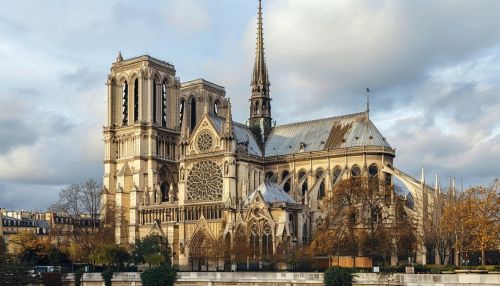Gothic architecture
Origins and Development
Gothic architecture, a style that originated in 12th-century France, is characterized by its use of pointed arches, ribbed vaults, and flying buttresses. It emerged from the Romanesque architectural style, which was characterized by its rounded arches and heavy use of stone. Gothic architecture, in contrast, was marked by its height and lightness, made possible by the innovative use of the flying buttress, which allowed for the construction of taller, thinner walls with larger windows.


The term "Gothic" was first used during the later Renaissance period as a derogatory term, relating to the barbarian Gothic tribes that had destroyed the Roman Empire and its classical culture by their invasions. The term was subsequently adopted and popularized in the 19th century by the French architect, Viollet-le-Duc, who led the Gothic Revival movement in France.
Characteristics
Gothic architecture is characterized by several key features, including pointed arches, ribbed vaults, and flying buttresses. These features allowed for the construction of taller, thinner walls with larger windows, which in turn allowed for more light to enter the building.
The pointed arch, one of the defining characteristics of Gothic architecture, was borrowed from Islamic architecture. It was more stable than the rounded arch used in Romanesque architecture, and allowed for greater variation in the structure and decoration of the building.
The ribbed vault, another key feature of Gothic architecture, was an evolution of the barrel vault used in Romanesque architecture. The ribbed vault allowed for the construction of a lighter, more stable structure, which in turn allowed for the construction of taller buildings with larger windows.
The flying buttress, perhaps the most iconic feature of Gothic architecture, was a structural innovation that allowed for the distribution of the weight of the roof to the outer walls. This allowed for the construction of taller, thinner walls with larger windows, which in turn allowed for more light to enter the building.
Examples
Some of the most famous examples of Gothic architecture include the Notre-Dame Cathedral in Paris, the Cologne Cathedral in Germany, and the Chartres Cathedral in France. These buildings are characterized by their height, their use of pointed arches, ribbed vaults, and flying buttresses, and their large, stained glass windows.
Influence and Legacy
The influence of Gothic architecture can be seen in many later architectural styles, including the Renaissance, Baroque, and Victorian styles. The Gothic Revival movement of the 19th century, led by architects such as Pugin and Viollet-le-Duc, saw a resurgence of interest in Gothic architecture, and led to the construction of many new buildings in the Gothic style.
